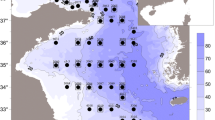Abstract
Methods are compiled and developed for the analysis of community structure in the deep-sea benthos. These methods are tailored to the conditions of high species diversity and low standing crop. A new modification of the 0.25-m2 box corer is described. Fisher's index of dispersion is adapted by using each species as a replicate. When the resultant summary statistic is partitioned in the illustrated manner, it is possible to determine whether species indeed behave as homegeneous replicates of a single dispersion pattern, or, alternatively, whether habitat partitioning is indicated. Species are also used as replicates in a modification of Pielou's “joins” technique of determining whether high-density and low-density areas of given species are randomly mingled. An indirect analytical approach is developed which proposes that, if an environmental grain of relatively small dimensions has been important in structuring the community, species which have smaller ambits will be more diverse than species having larger ambits.
Similar content being viewed by others
Literature Cited
Chua, K.E. and R.O. Brinkhurst: Evidence of interspecific interactions in the respiration of tubificid oligochaetes. J. Fish. Res. Bd Can. 30, 617–622 (1973)
Colwell, R.K.: Competition and coexistence in a simple tropical community. Am. Nat. 107, 737–760 (1973)
Dayton, P.K. and R.R. Hessler: Role of biological disturbance in maintaining diversity in the deep sea. Deep-Sea Res. 19, 199–208 (1972)
Diamond, J.M.: Distributional ecology of New Guinea birds. Science, N.Y. 179, 759–769 (1973)
Doyle, R.W.: Genetic variation in Ophiomusium lymani (Echinodermata) populations in the deep sea. Deep-Sea Res. 19, 661–664 (1972)
Fager, E.W.: Diversity: a sampling study. Am. Nat. 106, 293–310 (1972)
— and J.A. McGowan: Zooplankton species groups in the North Pacific. Science, N.Y. 140, 453–460 (1963)
Fisher, R.A.: Statistical methods for research workers (14th edition), 362 pp. Darien, Connecticut: Hafner 1970
Gage, J. and A.D. Geekie: Community structure of the benthos in Scottish sea-lochs. II. Spatial pattern. Mar. Biol. 19, 41–53 (1973)
Grassle, J.F. and H.L. Sanders: Life histories and the role of disturbance. Deep-Sea Res. 20, 643–659 (1973)
Gooch, J.L. and T.J.M. Schopf: Genetic variability in the deep sea: relation to environmental variability. Evolution, N.Y. 26, 545–552 (1972)
Hessler, R.R. and P.A. Jumars: Abyssal community analysis from replicate box cores in the central North Pacific. Deep-Sea Res. 21, 185–209 (1974)
— and H.L. Sanders: Faunal diversity in the deep sea. Deep-Sea Res. 14, 65–78 (1967)
Hurlbert, S.N.: The nonconcept of species diversity: a critique and alternative parameters. Ecology 52, 577–586 (1971)
Hutchinson, G.E.: The concept of pattern in ecology. Proc. Acad. nat. Sci. Philad. 105, 1–12 (1953)
—: The paradox of the plankton. Am. Nat. 95, 137–146 (1961)
Johnson, N.L. and S. Kotz: Discrete distributions, 328 pp. Boston, Massachusetts: Houghton-Mifflin 1969
Kershaw, K.A.: Association and co-variance analysis of plant communities. J. Ecol. 49, 643–654 (1961)
Kohn, A.J.: Diversity, utilization of resources and adaptive radiation in shallow-water marine invertebrates of tropical oceanic islands. Limnol. Oceanogr. 16, 332–348 (1971)
Krishna Iyer, P.V.: The first and second moments of some probability distributions arising from points on a lattice and their application. Biometrika 36, 135–141 (1949)
Levins, R.: Evolution in changing environments, 120 pp. Princeton, New Jersey: Princeton University Press 1968
Lloyd, M.: Mean crowding. J. Anim. Ecol. 36, 1–30 (1967)
MacArthur, R.H.: Population ecology of some warblers of Northeastern coniferous forests. Ecology 39, 599–619 (1958)
—: Patterns of communities in the tropics. Biol. J. Linn. Soc. 1, 19–30 (1969)
— Geographical ecology: patterns in the distribution of species, 269 pp. New York, N.Y.: Harper & Row 1972
— and E.O. Wilson: The theory of island biogeography, 203 pp. Princeton, New Jersey: Princeton University Press 1967
McIntyre, A.D.: Efficiency of benthos sampling gear. In: Methods for the study of marine benthos, pp 140–146. Ed. by N.A. Holme and A.D. McIntyre. Oxford, England: Blackwell 1971
Pielou, E.C.: An introduction to mathematical ecology, 286 pp. New York, N.Y.: Wiley-Interscience 1969
—: Measurement of structure in animal communities. In: Ecosystem structure and function, pp 113–135. Ed. by J.A. Weins. Corvallis, Oregon: Oregon State University Press 1972
Rao, C.R.: Linear statistical inference and its applications (2nd ed.), 625 pp. New York, N.Y.: John Wiley & Sons 1973
Reddingius, J. and P.J. den Boer: Simulation experiments illustrating stabilization of animal numbers by spreading of risk. Oecologia (Berl.) 5, 240–284 (1970)
Richerson, P., R. Armstrong and C.R. Goldman: Contemporaneous disequilibrium, a new hypothesis to explain the “paradox of the plankton.” Proc. natn. Acad. Sci. U.S.A. 67, 1710–1714 (1970)
Sanders, H.L.: Marine benthic diversity: a comparative study. Am. Nat. 102, 243–282 (1968)
— and R.R. Hessler: Ecology of the deep-sea benthos. Science, N.Y. 163, 1419–1424 (1969)
Schoener, T.W.: Resource partitioning in ecological communities. Science, N.Y. 185, 27–39 (1974)
Sokal, R.R. and F.J. Rohlf: Biometry, 776 pp. San Francisco, California: Freeman 1969
Wigley, R.L.: Comparative efficiencies of van Veen and Smith-McIntyre grab samplers as revealed by motion pictures. Ecology 48, 168–169 (1967)
Author information
Authors and Affiliations
Additional information
Communicated by O. Kinne, Hamburg
This paper is largely derived from a portion of a dissertation submitted to Scripps Institution of Oceanography of the University of California at San Diego in partial fulfillment of the requirements for the Ph.D. degree
Rights and permissions
About this article
Cite this article
Jumars, P.A. Methods for measurement of community structure in deep-sea macrobenthos. Marine Biology 30, 245–252 (1975). https://doi.org/10.1007/BF00390747
Accepted:
Issue Date:
DOI: https://doi.org/10.1007/BF00390747




